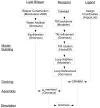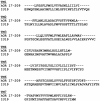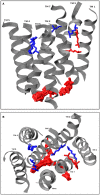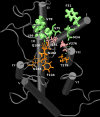Beyond modeling: all-atom olfactory receptor model simulations
- PMID: 22563330
- PMCID: PMC3342527
- DOI: 10.3389/fgene.2012.00061
Beyond modeling: all-atom olfactory receptor model simulations
Abstract
Olfactory receptors (ORs) are a type of GTP-binding protein-coupled receptor (GPCR). These receptors are responsible for mediating the sense of smell through their interaction with odor ligands. OR-odorant interactions marks the first step in the process that leads to olfaction. Computational studies on model OR structures can generate focused and novel hypotheses for further bench investigation by providing a view of these interactions at the molecular level beyond inferences that are drawn merely from static docking. Here we have shown the specific advantages of simulating the dynamic environment associated with OR-odorant interactions. We present a rigorous protocol which ranges from the creation of a computationally derived model of an olfactory receptor to simulating the interactions between an OR and an odorant molecule. Given the ubiquitous occurrence of GPCRs in the membranes of cells, we anticipate that our OR-developed methodology will serve as a model for the computational structural biology of all GPCRs.
Keywords: GPCR; ligand binding; lipid bilayer; molecular dynamics; olfactory receptor; protein modeling.
Figures







Similar articles
-
Computational Biology of Olfactory Receptors.Curr Bioinform. 2009 Jan;4(1):8-15. doi: 10.2174/157489309787158143. Curr Bioinform. 2009. PMID: 21984880 Free PMC article.
-
Molecular Basis of Mammalian Odor Discrimination: A Status Report.J Agric Food Chem. 2018 Dec 26;66(51):13346-13366. doi: 10.1021/acs.jafc.8b04471. Epub 2018 Dec 7. J Agric Food Chem. 2018. PMID: 30453735 Review.
-
Scents and sense: in silico perspectives on olfactory receptors.J Comput Chem. 2014 Dec 15;35(32):2279-87. doi: 10.1002/jcc.23757. Epub 2014 Oct 18. J Comput Chem. 2014. PMID: 25327850 Review.
-
Developing human olfactory network and exploring olfactory receptor-odorant interaction.J Biomol Struct Dyn. 2023 Oct-Nov;41(18):8941-8960. doi: 10.1080/07391102.2022.2138976. Epub 2022 Oct 30. J Biomol Struct Dyn. 2023. PMID: 36310099
-
Computational Approaches for Decoding Select Odorant-Olfactory Receptor Interactions Using Mini-Virtual Screening.PLoS One. 2015 Jul 29;10(7):e0131077. doi: 10.1371/journal.pone.0131077. eCollection 2015. PLoS One. 2015. PMID: 26221959 Free PMC article.
Cited by
-
Agonist Binding to Chemosensory Receptors: A Systematic Bioinformatics Analysis.Front Mol Biosci. 2017 Sep 6;4:63. doi: 10.3389/fmolb.2017.00063. eCollection 2017. Front Mol Biosci. 2017. PMID: 28932739 Free PMC article.
-
Preferential binding of an odor within olfactory receptors: a precursor to receptor activation.Chem Senses. 2014 Feb;39(2):107-23. doi: 10.1093/chemse/bjt060. Epub 2014 Jan 7. Chem Senses. 2014. PMID: 24398973 Free PMC article.
-
ORDB, HORDE, ODORactor and other on-line knowledge resources of olfactory receptor-odorant interactions.Database (Oxford). 2016 Oct 2;2016:baw132. doi: 10.1093/database/baw132. Print 2016. Database (Oxford). 2016. PMID: 27694208 Free PMC article.
-
Understanding Ligand Binding to G-Protein Coupled Receptors Using Multiscale Simulations.Front Mol Biosci. 2019 May 3;6:29. doi: 10.3389/fmolb.2019.00029. eCollection 2019. Front Mol Biosci. 2019. PMID: 31131282 Free PMC article. Review.
-
Sense of Smell: Structural, Functional, Mechanistic Advancements and Challenges in Human Olfactory Research.Curr Neuropharmacol. 2019;17(9):891-911. doi: 10.2174/1570159X17666181206095626. Curr Neuropharmacol. 2019. PMID: 30520376 Free PMC article.
References
Grants and funding
LinkOut - more resources
Full Text Sources

